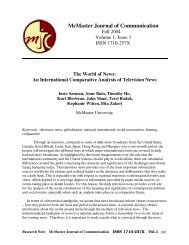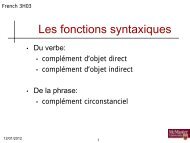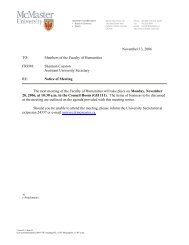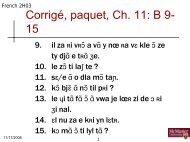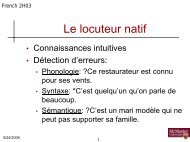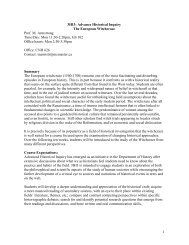The Syntax of Givenness Ivona Kucerová
The Syntax of Givenness Ivona Kucerová
The Syntax of Givenness Ivona Kucerová
You also want an ePaper? Increase the reach of your titles
YUMPU automatically turns print PDFs into web optimized ePapers that Google loves.
is not given but its movement is necessary to facilitate G-movement <strong>of</strong> some other given<br />
element.<br />
As a consequence, we predict that the verb may appear on either side <strong>of</strong> the partition<br />
between given and new. 17 If the head itself undergoes G-movement, the partition follows<br />
the head. 18 If the head moves in order to facilitate G-movement, the partition precedes the<br />
head. Thus we predict the pattern to be as in (34).<br />
(34) a. O V || S ←− head undergoes G-movement<br />
b. O || V S ←− head facilitates G-movement<br />
<strong>The</strong> pattern is indeed correct. Example (32-c) is not only a felicitous answer to the question<br />
And what about the lollipop? What happened to the lollipop? but it is also a felicitous<br />
answer to the question Who found the lollipop?, as in (35).<br />
(35) a. Who found the lollipop?<br />
b. Lízátko našla || malá holčička.<br />
lollipop.Acc found little girl.Nom<br />
‘A little girl found the lollipop.’<br />
In other words, the semantic ambiguity that we found with a basic word order repeats itself<br />
on a smaller scale here as well. Even though we know that because <strong>of</strong> G-movement <strong>of</strong><br />
the object, the object is given (translated as the lollipop), we cannot conclude anything<br />
about the status <strong>of</strong> the verb. <strong>The</strong> reason is that the head might have undergone either G-<br />
movement, or it might have moved only in order to facilitate G-movement. <strong>The</strong> suggested<br />
derivation is given in (36). For now I leave open the question <strong>of</strong> the exact landing site <strong>of</strong><br />
G-movement. In the following graphs, the landing site is marked as ?P.<br />
(36) a. VP<br />
V<br />
Object<br />
b. vP<br />
Subject<br />
vP<br />
v-V<br />
VP<br />
V<br />
Object<br />
17 Notice that the verb can be either the rightmost element in the given part, or it can follow the given part<br />
but it can never intervene between two given elements. Thus if, for example, both the subject and the object<br />
are given the resulting order is either SOV or OSV, depending on other factors such as topicalization.<br />
18 I put aside for now what determines the relative order <strong>of</strong> the given elements. I will address this question<br />
in chapter 3.<br />
24







